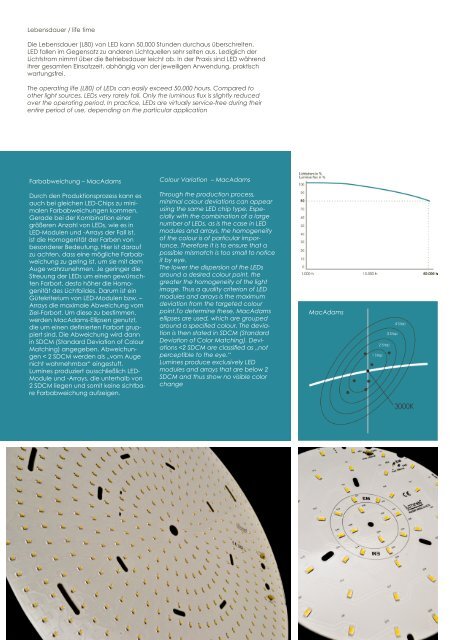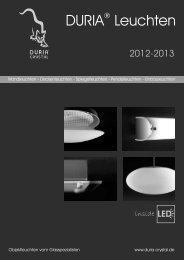LED Engines 2013 / 2014
Sie wollen auch ein ePaper? Erhöhen Sie die Reichweite Ihrer Titel.
YUMPU macht aus Druck-PDFs automatisch weboptimierte ePaper, die Google liebt.
Lebensdauer / life time<br />
Die Lebensdauer (L80) von <strong>LED</strong> kann 50.000 Stunden durchaus überschreiten.<br />
<strong>LED</strong> fallen im Gegensatz zu anderen Lichtquellen sehr selten aus. Lediglich der<br />
Lichtstrom nimmt über die Betriebsdauer leicht ab. In der Praxis sind <strong>LED</strong> während<br />
ihrer gesamten Einsatzzeit, abhängig von der jeweiligen Anwendung, praktisch<br />
wartungsfrei.<br />
The operating life (L80) of <strong>LED</strong>s can easily exceed 50,000 hours. Compared to<br />
other light sources, <strong>LED</strong>s very rarely fail. Only the luminous flux is slightly reduced<br />
over the operating period. In practice, <strong>LED</strong>s are virtually service-free during their<br />
entire period of use, depending on the particular application<br />
Farbabweichung – MacAdams<br />
Durch den Produktionsprozess kann es<br />
auch bei gleichen <strong>LED</strong>-Chips zu minimalen<br />
Farbabweichungen kommen.<br />
Gerade bei der Kombination einer<br />
größeren Anzahl von <strong>LED</strong>s, wie es in<br />
<strong>LED</strong>-Modulen und -Arrays der Fall ist,<br />
ist die Homogenität der Farben von<br />
besonderer Bedeutung. Hier ist darauf<br />
zu achten, dass eine mögliche Farbabweichung<br />
zu gering ist, um sie mit dem<br />
Auge wahrzunehmen. Je geringer die<br />
Streuung der <strong>LED</strong>s um einen gewünschten<br />
Farbort, desto höher die Homogenität<br />
des Lichtbildes. Darum ist ein<br />
Gütekriterium von <strong>LED</strong>-Modulen bzw. –<br />
Arrays die maximale Abweichung vom<br />
Ziel-Farbort. Um diese zu bestimmen,<br />
werden MacAdams-Ellipsen genutzt,<br />
die um einen definierten Farbort gruppiert<br />
sind. Die Abweichung wird dann<br />
in SDCM (Standard Deviation of Colour<br />
Matching) angegeben. Abweichungen<br />
< 2 SDCM werden als „vom Auge<br />
nicht wahrnehmbar“ eingestuft.<br />
Lumines produziert ausschließlich <strong>LED</strong>-<br />
Module und -Arrays, die unterhalb von<br />
2 SDCM liegen und somit keine sichtbare<br />
Farbabweichung aufzeigen.<br />
Colour Variation – MacAdams<br />
Through the production process,<br />
minimal colour deviations can appear<br />
using the same <strong>LED</strong> chip type. Especially<br />
with the combination of a large<br />
number of <strong>LED</strong>s, as is the case in <strong>LED</strong><br />
modules and arrays, the homogeneity<br />
of the colour is of particular importance.<br />
Therefore it is to ensure that a<br />
possible mismatch is too small to notice<br />
it by eye.<br />
The lower the dispersion of the <strong>LED</strong>s<br />
around a desired colour point, the<br />
greater the homogeneity of the light<br />
image. Thus a quality criterion of <strong>LED</strong><br />
modules and arrays is the maximum<br />
deviation from the targeted colour<br />
point.To determine these, MacAdams<br />
ellipses are used, which are grouped<br />
around a specified colour. The deviation<br />
is then stated in SDCM (Standard<br />
Deviation of Color Matching). Deviations<br />



